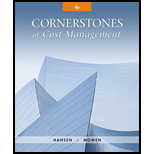
Bill Fremont, division controller and CMA, was upset by a recent memo he received from the divisional manager, Steve Preston. Bill was scheduled to present the division’s financial performance at headquarters in one week. In the memo, Steve had given Bill some instructions for this upcoming report. In particular, Bill had been told to emphasize the significant improvement in the division’s profits over last year. Bill, however, didn’t believe that there was any real underlying improvement in the division’s performance and was reluctant to say otherwise. He knew that the increase in profits was because of Steve’s conscious decision to produce more inventory.
In an earlier meeting, Steve had convinced his plant managers to produce more than they knew they could sell. He argued that by deferring some of this period’s fixed costs, reported profits would jump. He pointed out two significant benefits. First, by increasing profits, the division could exceed the minimum level needed so that all the managers would qualify for the annual bonus. Second, by meeting the budgeted profit level, the division would be better able to compete for much-needed capital. Bill objected but had been overruled. The most persuasive counterargument was that the increase in inventory could be liquidated in the coming year as the economy improved. Bill, however, considered this event unlikely. From past experience, he knew that it would take at least two years of improved market demand before the productive capacity of the division was exceeded.
Required:
- 1. Discuss the behavior of Steve Preston, the divisional manager. Was the decision to produce for inventory an ethical one?
- 2. What should Bill Fremont do? Should he comply with the directive to emphasize the increase in profits? If not, what options does he have?
- 3. Chapter 1 listed ethical standards for
management accountants. Identify any standards that apply in this situation.
Want to see the full answer?
Check out a sample textbook solution
Chapter 18 Solutions
Cornerstones of Cost Management (Cornerstones Series)
- Sarah martinez weekly gross earning for the solve this question general Accountingarrow_forwardNo AI ANSWERarrow_forwardMarquis Company estimates that annual manufacturing overhead costs will be $839,000. Estimated annual operating activity bases are direct labor cost $501,000, direct labor hours 52,000, and machine hours 101,000. Compute the predetermined overhead rate for each activity base. (Round answers to 2 decimal places, e.g. 10.50.)arrow_forward
 Cornerstones of Cost Management (Cornerstones Ser...AccountingISBN:9781305970663Author:Don R. Hansen, Maryanne M. MowenPublisher:Cengage Learning
Cornerstones of Cost Management (Cornerstones Ser...AccountingISBN:9781305970663Author:Don R. Hansen, Maryanne M. MowenPublisher:Cengage Learning Managerial Accounting: The Cornerstone of Busines...AccountingISBN:9781337115773Author:Maryanne M. Mowen, Don R. Hansen, Dan L. HeitgerPublisher:Cengage Learning
Managerial Accounting: The Cornerstone of Busines...AccountingISBN:9781337115773Author:Maryanne M. Mowen, Don R. Hansen, Dan L. HeitgerPublisher:Cengage Learning

